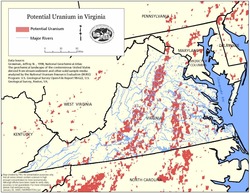Virginia uranium mining panel meets as concerns grow over health impacts
 A special panel of the National Academy of Sciences is meeting in Richmond, Va. today to gather information for its study on whether uranium can be mined and milled safely in the state.
A special panel of the National Academy of Sciences is meeting in Richmond, Va. today to gather information for its study on whether uranium can be mined and milled safely in the state.This will be the NAS panel's last town hall-style meeting in Virginia for public comment, and dozens of citizens are expected to turn out to urge the state legislature to keep its current ban on uranium mining in place.
The NAS study was requested by the Virginia Coal and Energy Commission in response to a proposal from Virginia Uranium Inc. to mine the largest-known undeveloped uranium deposit in the United States, located in Southside Virginia's Pittsylvania County near the North Carolina border.
The company argues that mining uranium in Virginia would bring benefits including more jobs and reduced dependence on foreign energy sources. But critics point to the trail of harm left by uranium mining elsewhere, from the toxic waste produced to health impacts, which include a documented increase in birth defects near uranium mining sites in New Mexico and health problems near uranium operations in Spain and Germany.
"Uranium was mined on Navajo Territory for over 50 years and the impacts are still felt," says Glen Besa, director of the Sierra Club's Virginia chapter. "This is not what Virginia wants in its future."
Today's meeting comes on the heels of a study released last week by the city of Virginia Beach that pointed out the area targeted for mining is susceptible to heavy rains and flooding. That in turn poses the threat of radioactive waste flowing into downstream drinking water supplies including Lake Gaston, which supplies drinking water to Virginia Beach as well as to Chesapeake and Norfolk, Va.
The study concluded that a worst-case storm -- such as Tropical Storm Gaston, which dumped 14 inches of rain on Virginia last year -- could overwhelm the mining operations and send radiation pouring downstream. It estimated that it could take anywhere from two months to two years to completely flush radioactive contaminants out of the lake.
"Environmental and water quality impacts upstream would be greater and longer lasting," according to a city press release.
Virginia Uranium Inc. is a privately held company that holds a majority interest in the proposed mining project. Holding a 22 percent indirect ownership interest in the project is Virginia Energy Resources Inc., formed by the 2009 merger of affiliate Virginia Uranium Ltd. and the Canadian uranium mining firm Santoy Resources.
The push to open Virginia to uranium mining comes as President Obama is promoting the expansion of commercial nuclear power in the United States. His administration announced last year that it would triple the budget for taxpayer-backed loan guarantees available for new reactors to $54 billion.
Tags
Sue Sturgis
Sue is the former editorial director of Facing South and the Institute for Southern Studies.
